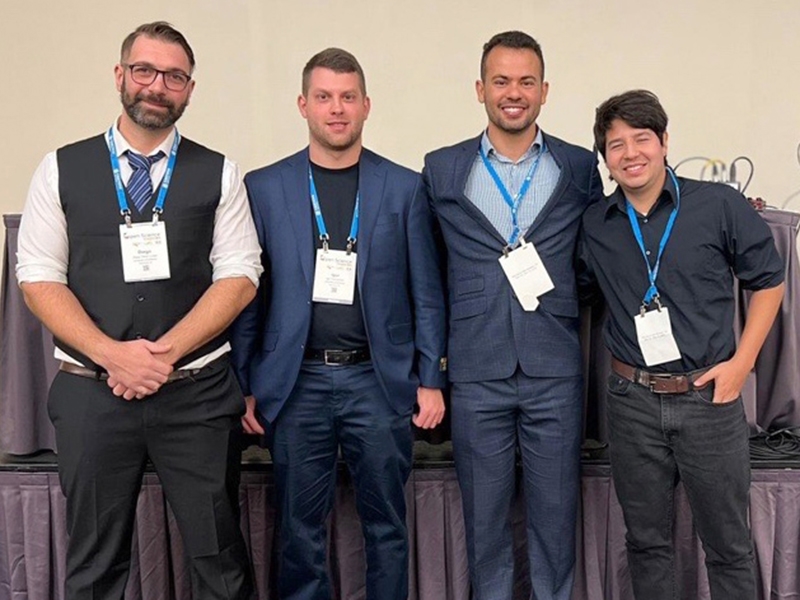Crop Science Grad Students Win ASA-CSSA-SSSA Ag Hackathon Competition

From left, U of A's team of Diego Della Lunga, Igor Fernandes, Gustavo Bessa de Lima and Mario Soto Valencia.
Four U of A graduate students in crop, soil and environmental sciences recently won an Ag Hackathon competition sponsored by the American Society of Agronomy, the Crop Science Society of America and the Soil Science Society of America.
U of A's team included Igor Fernandes, who focuses on statistics; Diego Della Lunga, who focuses on soil physics; Gustavo Bessa de Lima, focus on soil fertility; and Mario Soto Valencia, focus on precision agriculture.
The challenge was "How can we get an accurate estimate of carbon stocks across a landscape with minimal ground truth data?"
"Starting with creating a statistical model capable of predicting temporal and spatial distribution of soil organic carbon (SOC), we used an approach that was behind a single discipline," Della Lunga said. "Knowing in soil science many of the variables and parameters tend to be influenced by each other, we used soil physics and pedogenesis to create a new parameter as a proxy for our predictions. We used soil water infiltration within the topsoil to calculate kinetic energy that we used to predict SOC. At each step, we combined statistics, data manipulation, soil science and thermodynamics principles to assure one perspective of the problem was not going to predominantly influence the results. The model, although in need of some improvement, showed encouraging results. All of our advisers provided great support throughout this project."
Fernandes is advised by Sam Fernandes, assistant professor of agricultural statistics and quantitative genetics; Della Lunga by Kris Brye, University Professor of applied soil physics and pedology; Valencia by Aurelie Poncet, assistant professor of precision agriculture; and Bessa by Trent Roberts, associate professor of soil fertility. All are faculty members of the Dale Bumpers College of Agricultural, Food and Life Sciences, and researchers and scientists with the Arkansas Agricultural Experiment Station, the research arm of the U of A System Division of Agriculture.
"After calculating kinetic energy, we started exploratory data analysis and found that fitting a log-log linear mixed model was useful to explain the relationship of soil organic carbon and kinetic energy, with the county as a random effect," said Igor Fernandes. "As a proof of concept, we used the same model fitted with Arkansas information to predict soil organic carbon in Coastal California, which showed an accuracy of 0.5% - 10% lower when compared to the Lower Mississippi River Valley predictions."
The Hackathon provided one opportunity for teams to meet in person at the ASA-CSSA-SSSA annual meeting and work. Teams could also meet outside of that meeting. Teams presented their findings on the last day of the conference in a 15-minute presentation and were judged according to a rubric. Judging was based on problem definition, data sources, analytical methods, results, impact, the final presentation and open science principles.
The ASA-CSSA-SSSA jointly host the premier gathering of ideas, solutions and innovation from across the field of environmental sciences. The annual meeting is equal parts science, networking, collaboration and camaraderie, and includes emerging learners and leaders from industry, government agencies and academic institutions to explore advances in agronomic, crop and soil sciences.
About the Dale Bumpers College of Agricultural, Food and Life Sciences: Bumpers College provides life-changing opportunities to position and prepare graduates who will be leaders in the businesses associated with foods, family, the environment, agriculture, sustainability and human quality of life; and who will be first-choice candidates of employers looking for leaders, innovators, policy makers and entrepreneurs. The college is named for Dale Bumpers, former Arkansas governor and longtime U.S. senator who made the state prominent in national and international agriculture. For more information about Bumpers College, visit our website, and follow us on Twitter at @BumpersCollege and Instagram at BumpersCollege.
About the University of Arkansas: As Arkansas' flagship institution, the U of A provides an internationally competitive education in more than 200 academic programs. Founded in 1871, the U of A contributes more than $2.2 billion to Arkansas' economy through the teaching of new knowledge and skills, entrepreneurship and job development, discovery through research and creative activity while also providing training for professional disciplines. The Carnegie Foundation classifies the U of A among the few U.S. colleges and universities with the highest level of research activity. U.S. News & World Report ranks the U of A among the top public universities in the nation. See how the U of A works to build a better world at Arkansas Research and Economic Development News.
Contacts
Robby Edwards, director of communications
Dale Bumpers College of Agricultural, Food and Life Sciences
479-575-4625, robbye@uark.edu